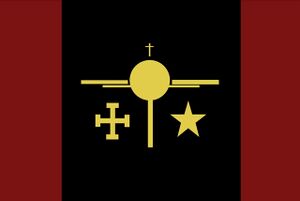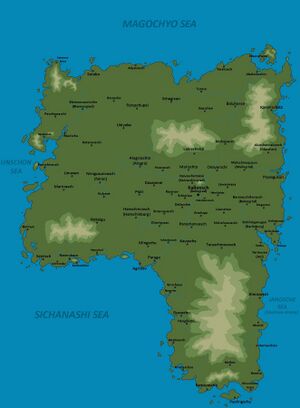Janpia: Difference between revisions
No edit summary |
No edit summary |
||
| Line 15: | Line 15: | ||
|image_map2 = [[File:Janpian Major Cities.jpg|thumb|center]] | |image_map2 = [[File:Janpian Major Cities.jpg|thumb|center]] | ||
|alt_map2 = | |alt_map2 = | ||
|map_caption2 = | |map_caption2 = Major Cities Map | ||
|capital = Kalingrad | |capital = Kalingrad | ||
|largest_city = capital | |largest_city = capital | ||
| Line 25: | Line 25: | ||
|demonym = Janpians / Jano | |demonym = Janpians / Jano | ||
|government_type = {{wpl|One-party|One-Party}} {{wpl|Socialist|Socialist}} {{wpl|State|State}} {{wpl|Union|Union}} | |government_type = {{wpl|One-party|One-Party}} {{wpl|Socialist|Socialist}} {{wpl|State|State}} {{wpl|Union|Union}} | ||
|leader_title1 = [[ | |leader_title1 = [[People's Marshal]] | ||
|leader_name1 = | |leader_name1 = Yorischa Juneschen | ||
|leader_title2 = [[Chairperson of the | |leader_title2 = [[Chairperson of the Party Centrall]] | ||
|leader_name2 = | |leader_name2 = NA | ||
|legislature = Union of Party Members Committee | |legislature = Union of Party Members Committee | ||
|sovereignty_type = History | |sovereignty_type = History | ||
Revision as of 12:56, 30 June 2022
This article is incomplete because it is pending further input from participants, or it is a work-in-progress by one author. Please comment on this article's talk page to share your input, comments and questions. Note: To contribute to this article, you may need to seek help from the author(s) of this page. |
Janpian Union of Revolutionary States | |
|---|---|
|
Flag | |
| Motto: Hardwork, Discipline, Unity | |
| Anthem: 'Forwards Janpians' | |
Map of Janpia | |
Major Cities Map | |
| Capital and largest city | Kalingrad |
| Official languages | English Janosche |
| Recognised national languages | Japanese Deutsch Russian English |
| Demonym(s) | Janpians / Jano |
| Government | One-Party Socialist State Union |
| Yorischa Juneschen | |
| NA | |
| Legislature | Union of Party Members Committee |
| History | |
• Kingdom | Year 1054 |
| 1 September 1939 | |
| 19 January 1943 | |
| 26 January 1943 - 5 September 1978 | |
| 1 June 1943 | |
| 25 April 1982 | |
| Area | |
• Total | 416,334 km2 (160,747 sq mi) |
| Population | |
• 2022 estimate | 201,000,000 |
• 2018 census | 194,667,000 |
• Density | 482.8/km2 (1,250.4/sq mi) |
| GDP (nominal) | 2022 estimate |
• Total | $8.79 Trillion |
• Per capita | $43730.48 |
| Gini (2018) | low |
| HDI (2022) | very high |
| Currency | JP |
| Time zone | UTC+1 (Janpian Standard Time) |
| Date format | dd.mm.yyyy |
| Driving side | right |
| Calling code | +37 |
| Internet TLD | .jur |
The Janpian Union of Revolutionary States, also known as the United Revolutionary States of Janpia is a nation located at the The Communist Bloc and has an estimated population of 777,000,000. Janpia is bounded by the Janpian Sea at the east, the Union Island Group at its west, the Gulf of Sichanashi to the south, and the Sea of Magochyo on the north. The nation is divided by the Munchen River, which cuts from Sichanashi Bay all the way to the Munchen Harbor at the north. The highest point of Janpia is the Area 64 Mountain Range, also known as the Chikali Mountain Range. The deepest geographic location is Point 122, located at the Bay of Sichanashi. The country also has a desert known as the Alevayev Desert. It is an ancient dried lake with possible volcanic activity. The desert is located at the Janpian Middle Land Region.
Janpia has various cultures, with some dating back to Era 1. The Janpian national bird is the raven. A symbol of pilosophy, intelligence, wisdom and death. It was chosen since it symbolizes the revolution against the empire and tyrants. The largest city in Janpia, is also the capital Kalingrad.
The nation is governed by the Janpian Union of Government Workers Party, which comprises all of the parties united under one name. The Janpian Union of Revolutionary States was born after the Janpian Civil War, which overthrew the Imperial Government and united all its western island colonies (the Union Islands), making them part of the nation's core territories.
The revolution is officially not yet over as the world is not enlightened by the revolutionary ideals. The goal of the revolution is to bring true peace, stability, equality and harmony to all nations through leftist ideals by destroying Janpian enemies and counter revolutionaries in any manner. If all of this is finished, the Party, along with the rest, will dissolve itself, creating a stateless, classless society of communes.
Etymology
The term Janpia comes from the 1st Era warlord Janoschpe III. He is responsible for uniting all the tribes and kingdoms of Janpia in a bloody campaign. The followers of Janoschpe III were later called Janosche, also known as Janpia.
Another term for Janpia is "Dabun Javosch." When translated to Janpian, it literally means "the land of the dead emperors". This is due to the fact that a lot of places were named after the death places of kings, emperors, or their lineage.
One of the examples is when King Magochyo of Munchen escaped to the sea in order to escape from the incoming Janpian imperial troops. He was never seen, or found ever again. Thus, the sea where he escaped is called the Sea of Magochyo.
Another example is the term "Janpia" or "Janosche," which means followers of King Janoschpe III. For many centuries, Janpia was ruled by the Janoschpe family, who had direct lineage to King Janoschpe III. They even managed to remain as "Emperors" during the colonial years of the 2nd Era. However, during the 4th era, the entire lineage of Emperor Janoschpe III and its followers were brutally killed during the civil war.
History
Main article: Historical Era Archives
The Janpian history is divided into eras. Each era signifies a different style of governance or struggle. The eras have no time limits, and it only changes when major historical events happens on Janpia
Janpian history is complex due to its long existance and the ever growing discovered historical evidences or artifacts. As such, the history has its own dedicated website runned by the Janpian Ministry of Collective Information and Archives.


